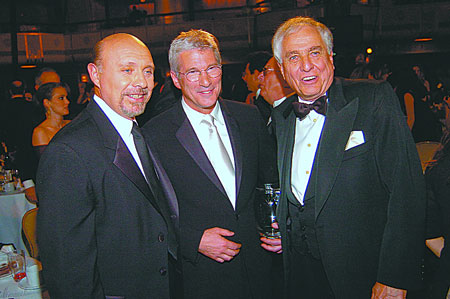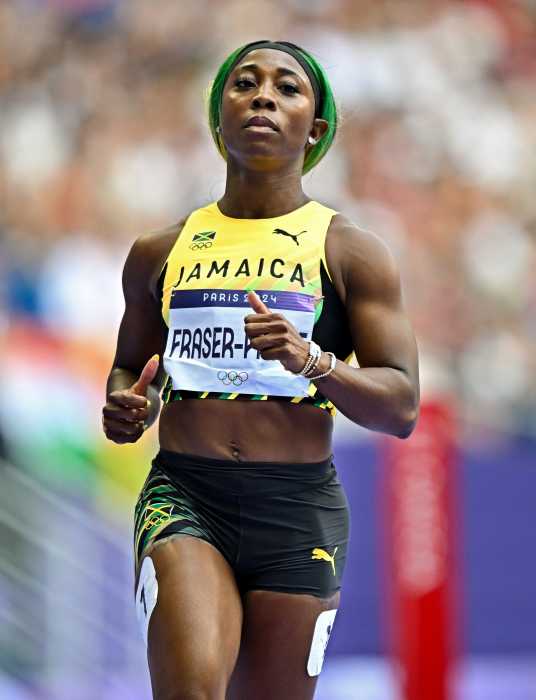Waldorf gala recalls the greatest movie moments of one really good kisser
When the time came for Richard Gere to say something nice about the American Museum of the Moving Image, he had a word for it. In fact, several good words for that cinematic historical beehive on the grounds of the old Kaufman Astoria Studios in Queens.
“When I was making ‘The Cotton Club’ [there], 18, 19 years ago,” the actor said, “there was no American Museum of the Moving Image. Rochelle Slovin created it out of nothin’ and turned it into somethin.’ A museum of whimsy, science, craft, emotions. It’s sweet, generous-and interactive!”
That last one was the word that best summarized the whole evening, April 13, when AMMI saluted Richard Gere with a black-tie gala at the Waldorf. Officer and gentleman Gere thus joined a roster that began with Sidney Lumet in 1985 and includes Elia Kazan, Sidney Poitier, Robert De Niro, Al Pacino, Stephen Spielberg, Martin Scorsese, Dustin Hoffman, Tom Hanks, and Julia Roberts—Gere’s “Pretty Woman” co-star—among others.
Interactive? You could say that again. There was, for starters, a table down in front large enough to hold Richard Gere’s entire family from Syracuse––his mother, his father, his sisters, his cousins, and his aunts. They and he all had something to say from time to time.
At the end, when, from the stage, Gere spoke of “these people who witnessed my life, beginning as a very shy, difficult, irascible, all of that stuff…,” his sister Susan broke in, loud and clear, with: “… and more!”
The actor thanked his mother for making him his Santa suit in second grade, and thanked his father “for being the guy I find myself becoming.” From the table, Gere senior, an insurance salesman, announced: “I still have my hair.”
“Mine is now the same color as yours,” said the white-maned son.
It was, after words of welcome from AMMI chair Herbert S. Schlosser and AMMI director Slovin, a skyrocket named Sharon Stone who, in very sheer flesh tones, launched her own opening lines toward the 700 dinner guests––that is to say, flubbed them, amidst laughter, some of it hers––over and over again a good three times.
“That’s why I’ve waited to do Broadway,” the pneumatic Ms. Stone cheerfully proclaimed.
“She almost has a dress on,” photographer Aubrey Ruben murmured in my ear.
Why was this gala AMMI evening different from all other gala AMMI evenings? Because, as a huge swooping, swirling camera boom and many technicians made manifest, it was being shot and edited like a movie––with starts, stops, breaks, retakes––for broadcast by the USA Network on Saturday, May 8.
A film clip of Gere, as charcoal hairy as the bearded Johnny Damon of the Boston Red Sox, trying to pick up Diane Keaton in “Looking for Mr. Goodbar,” Gere’s 1977 breakthrough movie, was followed by an intense Stone-Gere marital strife scene from “Intersection” (1994).
“No matter how chilly and strange,” Stone said of that moviemaking experience, “you made me a better actress… But let it be also said that you have also established yourself as one of the greatest and most accomplished kissers in the whole history of cinema.”
There followed a montage of mouth-to-mouth resuscitations between Richard Gere and this one and that one in 20 or 30 motion pictures, a sort of one-man’s climactic “Cinema Paradiso.” After which Ms. Stone was called upon to reprise her scripted opening lines of ten minutes earlier. “Now COME on!” she said when she blew them again.
Finally she got it right: “We are pleased to look at you and your fine body of work for an entire evening… This, ladies and gentlemen, is one GORGEOUS museum piece…”
Stone drew a breath.
“I like the first one,” she said of her line readings.
Stone was not alone in her difficulties. Even such experienced stage actors as Laura Linney and Liam Neeson had problems with their lines and could not fully be heard, while Winona Ryder, giggling, more or less disappeared into the wallpaper.
What brought life, laughter, and energy into the proceedings was the joint appearance of Garry Marshall, director of Gere’s “Pretty Woman” (1990), and Hector Elizondo, who played the taut, understanding hotel manager in that worldwide hit.
Marshall and Elizondo kicked around the description of Richard Gere as “a moody, rebellious, sulky guy.”
“So what?” said Marshall, “he’s from Syracuse.”
“I’m from Harlem,” Elizondo said.
“I’m from the Bronx,” said Marshall. “The moody people come from Syracuse.”
Elizondo remembered when he was in another Gere movie. “I was a cop chasing him when he was a hooker in ‘American Gigolo.’”
“He’s a good kisser,” said Marshall. “He has chemistry. He can have chemistry with a telephone pole. He has beautiful silver hair.”
Marshall, a director of countless large screen and small screen hits who described his directing as “louder, softer, fast, slow, why get into all that other stuff,” introduced the next film clip as “one of the best scenes I ever stood out of the way of.”
It is indeed a delicious scene, Julia Roberts in a bubble bath in “Pretty Woman,” with Gere, on the edge of the tub, offering her a few thousand dollars “to be at my beck and call for several days.” She lets out a whoop of “Holy shit,” ducks under the water, comes back up with a sunlit em-bubbled smile and “Well, I want to be your beck-and-call girl.”
A brusque and bracing contrast was now supplied by Louis Gossett, Jr., the hard-as-nails drill sergeant who put cadet Gere through his paces in “An Officer and a Gentleman” (1982).
“If it wasn’t for you, I wouldn’t have got an Oscar. Richard, thank you,” said Gossett. “So here we are, 22 years later… Richard’s approach to acting is three-dimensional. He jumps into a character with four feet. But the way to work with Richard is to push him.”
Things got interactive again when squeals and screams were heard throughout the prestigious Grand Ballroom of the Waldorf Astoria as young actor Gere jiggled and bounced his way through his wardrobe undressing scene in “American Gigolo” (1980).
“This is a male star who could only come from Syracuse,” said Liam Neeson.
“Stripped,” he thoughtfully added.
Up jumped Gere from his seat at the family table.
“Who thinks that scene was good enough?” he shouted to the room at-large. And the room at-large answered back with a fusillade of applause and cheering. Like the man said, interactive. Moody, rebellious, sulky Richard Gere stood in the middle of the uproar, stuffing a napkin into his mouth to keep from, one supposes, collapsing in giggles like a child.
There was more, there was more; there was Denzel Washington––amidst the further cheers for song-and-dance man Gere’s film clip striptease in “Chicago”–– saying, “Not yet, Richard, not yet. Sit down.”
And then Washington remarked how the man of the hour had been “a major movie star for two decades while always holding onto his soul”––with the man of the hour shouting up from where he was seated: “Three decades!”
And then, finally––well, almost finally––there was Richard Gere, on stage, thanking his mother, his father, his wife Carey Lowell, his small son, his sisters, his cousins, and his aunts. And oh yes, Garry Marshall, “the epiphanal person in my life.” And two more people, whom Gere made sure were invited to this shindig, and whom he now, one at a time, made stand up and take a bow.
They were Doris Abramson, his teacher back in his two years at the University of Massachusetts at Amherst (“She made me feel I had something to offer”), and Wynn Handman, “my first real teacher in the real world––in scenes from ‘Henry V’ in class he got me to trust the language, trust the writer. ‘Dive in — he’ll carry you.’ I didn’t know this, but Wynn was Denzel’s teacher too.”
That was it.
“One thing I’ve learned in life,” Gere said to close out the proceedings. “Never trust anyone who exclusively thinks he has God on his side.”
Two beats.
“Especially when it’s the president of the United States.”
One movie star, one actor, interactive.

































